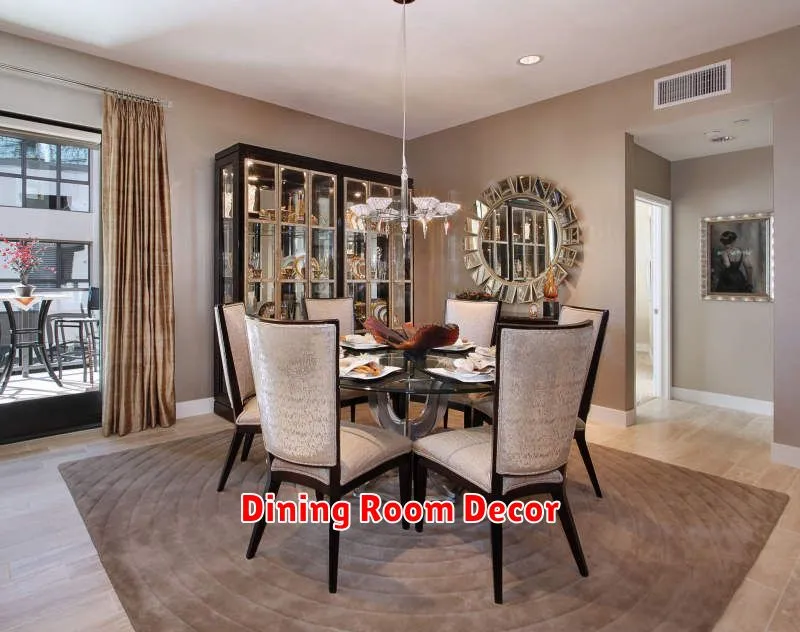Transform your dining room into a space that reflects your personal style and enhances your dining experience with these 8 creative decor tips. Whether you’re aiming for a modern minimalist look, a rustic farmhouse charm, or a luxurious elegant ambiance, this guide offers innovative ideas and practical advice to elevate your dining room design. Discover how to effectively utilize lighting, color palettes, unique furniture, and statement accessories to create a truly unforgettable and functional dining area. Learn how to achieve the perfect dining room decor for your home.
Statement Dining Table Centerpieces

A dining table centerpiece serves as the focal point of any dinner party or special occasion. It sets the tone and enhances the overall aesthetic appeal of your dining area. Choosing the right centerpiece is crucial for creating a memorable and sophisticated ambiance.
The ideal centerpiece should complement your existing décor while reflecting the theme and formality of the event. Consider the size of your dining table; an overly large centerpiece can overwhelm a small table, while a tiny one can get lost on a large surface. Scale is paramount.
Floral arrangements remain a classic and versatile option. From simple, elegant bouquets to elaborate, cascading displays, flowers can instantly elevate the mood and add a touch of freshness. Color palettes should harmonize with your table linens and dinnerware. Consider incorporating seasonal blooms for a natural and timely touch.
For a more modern and minimalist approach, consider using sculptural objects or interesting collections as your centerpiece. A grouping of unique candlesticks, decorative bowls, or even a collection of interesting rocks can create a visually stunning and conversation-starting focal point. The key is to curate pieces with a cohesive aesthetic.
Lighting plays a significant role in enhancing your centerpiece. Using candles, strategically placed votives, or even a low-hanging pendant light can dramatically impact the ambiance. Soft, warm lighting is generally preferred for creating a relaxing and intimate atmosphere.
Ultimately, the best dining table centerpiece is one that reflects your personal style and creates a welcoming and enjoyable setting for your guests. Remember to consider the overall theme, color scheme, and size of your table when making your selection. A thoughtfully chosen centerpiece can transform a simple dinner into a truly memorable occasion.
Wall Art for Dining Areas

Selecting the right wall art for your dining area can significantly enhance the overall ambiance and reflect your personal style. The dining room is often a focal point for family gatherings and entertaining guests, making the choice of artwork particularly important.
Consider the size and scale of your dining room when choosing artwork. A large piece can create a dramatic statement in a spacious room, while smaller pieces might be more suitable for a cozy setting. Proportion is key to achieving a balanced and visually appealing space. Overly large artwork can overwhelm a small room, whereas too small a piece may get lost in a larger one.
The style of your artwork should complement the existing décor of your dining area. A modern dining room might benefit from abstract art or minimalist prints, while a traditional setting might be better suited to classic landscapes or still lifes. Consistency in style between the artwork and the furniture will create a cohesive and harmonious look.
Color palette is another crucial aspect to consider. The colors in your artwork should either complement or contrast with the existing color scheme in your dining room. Choose colors that enhance the overall mood and create a visually pleasing atmosphere. Bold colors can add energy and vibrancy, while softer tones can promote a sense of calm and relaxation.
Finally, don’t underestimate the impact of framing. The frame should complement the artwork and the overall style of your dining room. A simple, understated frame might be suitable for a modern piece, while an ornate frame could enhance a more traditional artwork. The right frame can elevate a piece and tie it all together.
By carefully considering these factors – size, style, color palette, and framing – you can select wall art that transforms your dining area into a stylish and inviting space that reflects your personality and taste.
Stylish Table Runners
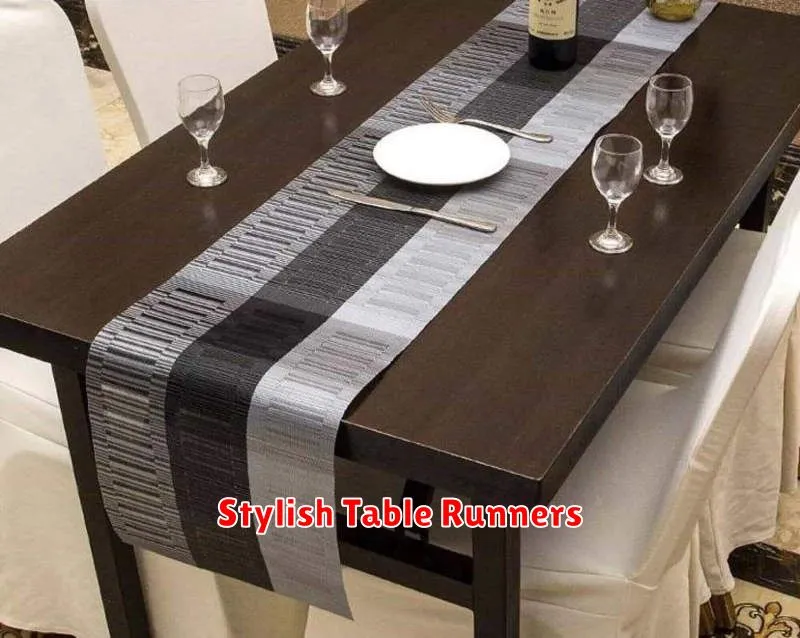
Table runners are a simple yet effective way to elevate the aesthetic of any dining table. They offer a versatile approach to interior design, allowing for seamless transitions between casual and formal settings. The right runner can instantly transform the atmosphere, adding a touch of elegance or a burst of vibrant color depending on your chosen style.
Choosing the right table runner involves considering several factors. The size is paramount; it should complement the dimensions of your table, neither overwhelming nor appearing lost in the space. The material also plays a significant role. Linen offers a relaxed, sophisticated feel, while silk provides a touch of luxurious opulence. More durable options such as cotton or polyester are ideal for frequent use and easy cleaning.
Beyond material, the color and pattern of your table runner are key design elements. Neutral tones like beige, cream, or gray provide a classic, timeless backdrop, allowing for flexibility in your choice of tableware and centerpiece. Conversely, bold patterns and vibrant hues inject personality and create a focal point for your dining area. Consider coordinating the runner with your existing décor or using it as an opportunity to introduce a contrasting accent.
Placement is crucial. A table runner should ideally be centered on the table, leaving sufficient space at each end. The length should allow for a visually pleasing drape, neither too short nor excessively long. The overall effect should be balanced and harmonious, enhancing the overall aesthetic of your dining experience.
Ultimately, selecting the perfect table runner is a matter of personal taste and stylistic preference. By considering factors such as size, material, color, pattern, and placement, you can effortlessly create a beautifully appointed dining space that reflects your individual style and enhances the overall ambience of your home.
Chandelier Lighting
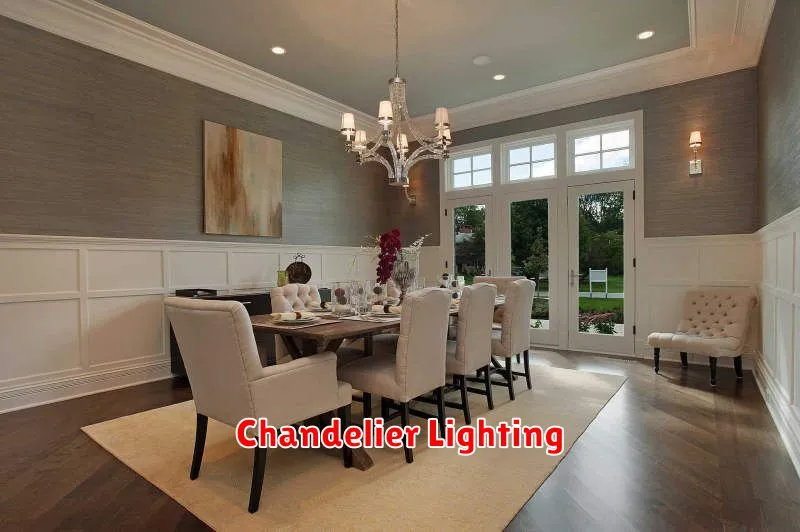
Chandeliers represent a classic and elegant form of lighting, capable of transforming the ambiance of any space. Their versatility allows for integration into diverse interior design styles, from traditional to modern.
The selection of a chandelier should consider several key factors. Room size is paramount; a diminutive chandelier in a vast space will appear lost, while an overly large one in a small room can feel overwhelming. Ceiling height is equally important, influencing the appropriate length and style of the fixture. The overall aesthetic of the room, including its color palette, furniture, and existing décor, should also be carefully considered to ensure harmonious integration.
A wide variety of materials are used in chandelier construction, each impacting both the aesthetic and the price point. Crystal chandeliers, renowned for their sparkle and luxurious appeal, represent a higher-end option. Metal chandeliers, such as those crafted from wrought iron or brass, offer a more durable and potentially less expensive alternative, with varying finishes to suit different design preferences. Wood and glass combinations also provide unique visual appeal.
Beyond aesthetics, the lighting capabilities of the chandelier are critical. The number of light sources and the type of bulbs utilized significantly affect the brightness and the overall illumination of the room. Consider whether ambient lighting, task lighting, or accent lighting is the primary requirement, or a combination thereof. Furthermore, the dimmability of the fixture offers additional control over the atmosphere.
In conclusion, choosing the right chandelier involves a careful assessment of space, style, and functionality. By considering these factors, one can select a fixture that not only enhances the visual appeal of the room but also provides optimal illumination and contributes to a welcoming and sophisticated atmosphere.
Mix-and-Match Dining Chairs

Creating a unique and stylish dining space doesn’t require a perfectly matched set of chairs. In fact, mixing and matching dining chairs can add personality and visual interest to your dining area. This design approach allows for greater flexibility and creative expression, enabling you to showcase your individual style.
The benefits of this approach are numerous. Firstly, it offers a fantastic opportunity to incorporate vintage or antique finds alongside modern pieces, creating a captivating blend of eras and styles. Secondly, you can easily adjust the number of chairs to suit your needs, adding or subtracting as required without the need for a complete set replacement. This is particularly useful for families that grow or change over time.
When choosing your mix-and-match chairs, consider establishing a cohesive theme. This doesn’t mean all chairs must match perfectly; rather, focus on unifying elements such as color palettes, material types, or design styles. For example, you could mix chairs with similar wood tones or choose a range of chairs with different designs but a consistent color scheme. This will prevent the look from becoming chaotic and maintain a sense of harmony.
Material selection plays a crucial role. Consider mixing different materials like wood, metal, or upholstered chairs for texture and visual contrast. A combination of sleek metal chairs and rustic wooden chairs, for example, can add a touch of sophistication and warmth. Don’t be afraid to experiment and find a balance that complements your dining table and the overall aesthetic of your space.
Finally, consider the scale and proportion of your chairs in relation to your dining table. While you can mix and match styles, ensure the chairs are relatively consistent in height and overall size to avoid an unbalanced look. A well-proportioned mix will create a visually pleasing and functional dining area that reflects your unique sense of style.
Colorful Crockery for Display
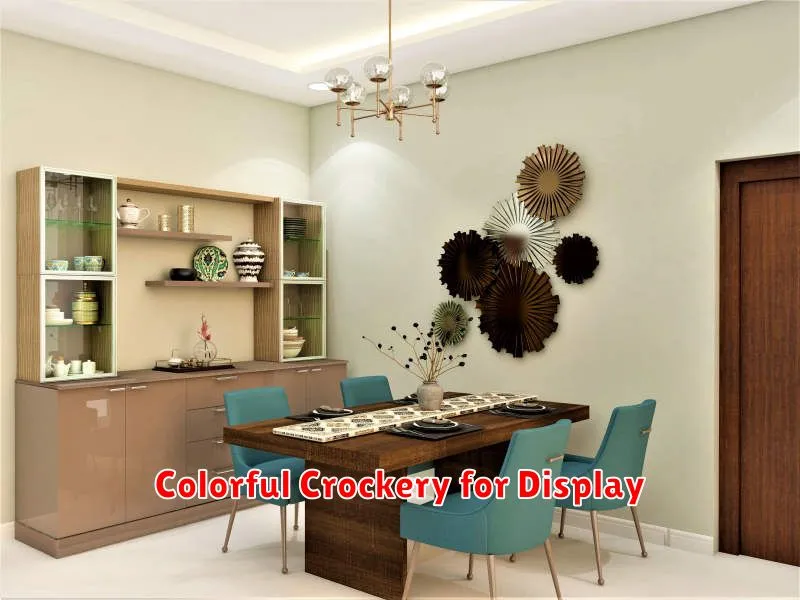
Colorful crockery can add a vibrant and personalized touch to any kitchen or dining space. More than just functional tableware, brightly colored plates, bowls, and mugs can serve as attractive display pieces, reflecting your unique style and adding a pop of personality to your home.
Consider the arrangement of your colorful crockery. Grouping similar colors together can create a cohesive and visually appealing display. Alternatively, mixing and matching various hues can result in a more eclectic and vibrant look. Think about using shelves, open cabinets, or even a decorative tiered stand to showcase your collection effectively.
The materials of your crockery also play a significant role in its visual appeal. Earthenware, stoneware, and porcelain each offer unique textures and finishes that can complement different decor styles. The sheen of glazed ceramics contrasts beautifully with the matte finish of unglazed pottery, adding depth and visual interest to your display.
Choosing a theme can help you curate a cohesive collection. Perhaps you prefer a bold, tropical palette, or a more muted, Scandinavian-inspired aesthetic. A consistent theme will ensure that your colorful crockery complements your overall home decor, creating a harmonious and stylish environment.
Don’t be afraid to experiment! The beauty of displaying colorful crockery is its inherent flexibility. You can rearrange your pieces frequently to refresh the look of your kitchen or dining area. Try different arrangements, incorporating other decorative elements like plants or textiles to create a truly unique and personalized display.
Ultimately, the most important aspect of displaying colorful crockery is to enjoy it. Select pieces that bring you joy and reflect your personality. Let your crockery tell your story and add a splash of color to your everyday life.
Adding a Rug Under the Table
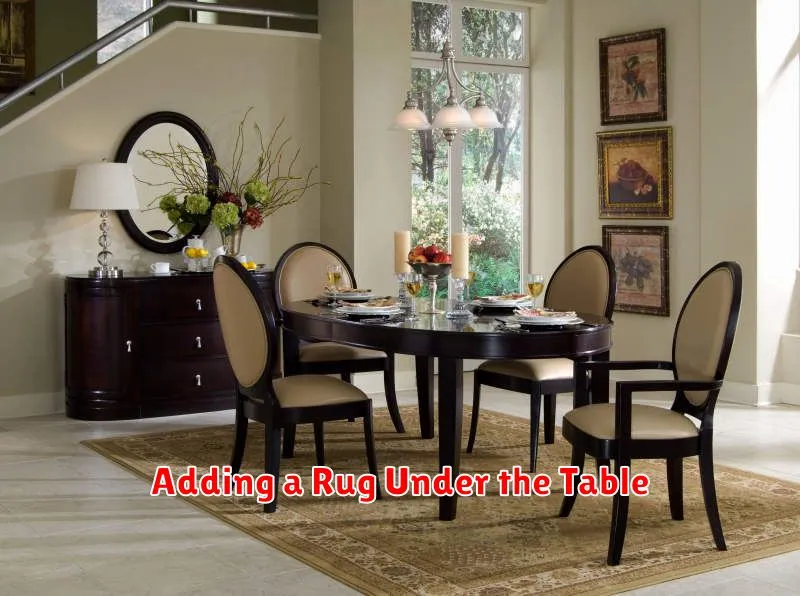
Adding a rug under your dining table can significantly enhance the aesthetic appeal and functionality of your dining space. It’s a simple yet effective way to transform the room’s ambiance.
Size is a crucial consideration. The rug should be large enough to accommodate all chairs when they are pulled out from the table. Ideally, you should have at least 24 inches of rug extending beyond each side of the table. This prevents chair legs from scraping the floor and creates a visually pleasing, unified look.
Material selection depends on your needs and style. Wool rugs are luxurious and durable, offering excellent insulation and sound absorption. Jute rugs provide a natural, eco-friendly option with a rustic charm. Synthetic rugs are often more affordable and easier to maintain, making them a practical choice for high-traffic areas.
Color and pattern should complement your existing décor. A neutral-toned rug can create a calming and sophisticated atmosphere, while a rug with a bold pattern can add a pop of personality and visual interest. Consider the colors of your walls, furniture, and other accessories to ensure a cohesive and harmonious design.
Once you’ve chosen your rug, placement is key. Center the rug under the table, ensuring even overhang on all sides. This creates a balanced and visually appealing arrangement. If the table is exceptionally large, consider placing a smaller rug beneath just the table and chairs, with an additional rug elsewhere in the room to anchor the space.
Finally, remember to protect your rug. Use rug pads to prevent slipping and extend its lifespan. Regular vacuuming will keep it looking its best, and spot cleaning can address any spills or stains promptly. With a little care, your rug will remain a beautiful and functional addition to your dining area for years to come.
Personalized Place Settings
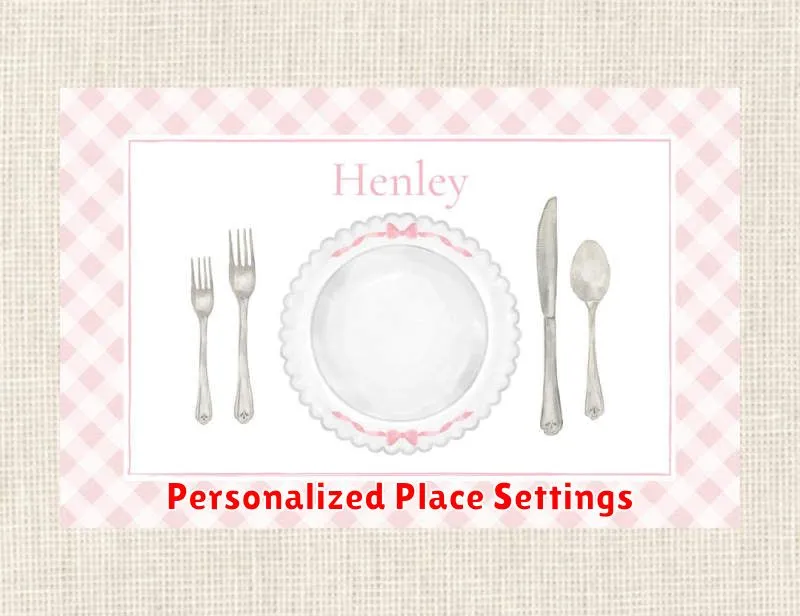
Elevate your dining experience with personalized place settings. They add a touch of elegance and sophistication to any meal, whether it’s a casual dinner with family or a formal gathering with friends.
The possibilities for personalization are endless. You can incorporate monograms, names, or even special dates to create truly unique settings. This thoughtful detail shows your guests that you’ve put extra care into their experience.
Consider the style of your dinnerware when choosing how to personalize your place settings. A simple monogram might be perfect for classic china, while a more elaborate design could complement a more modern aesthetic. Color coordination is also key; ensure the personalization complements, rather than clashes with, your overall table setting.
Beyond the traditional name cards, explore various ways to personalize. You can use customized napkin rings, engraved silverware, or even small personalized favors placed at each setting. These little details can make a big impact.
Creating personalized place settings doesn’t have to be expensive. There are many affordable options available, from printable name cards and stickers to readily available personalized napkin rings. The key is to find a method that aligns with your budget and aesthetic preferences.
Ultimately, personalized place settings add a unique and memorable touch to any meal. They demonstrate your thoughtfulness and create a welcoming atmosphere for your guests. So go ahead and personalize; it’s a simple gesture that makes a significant difference.

